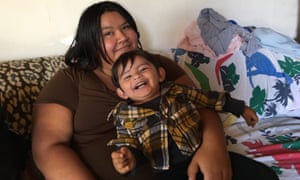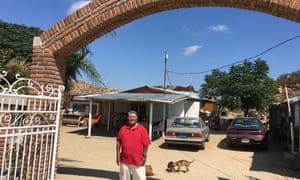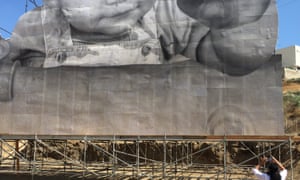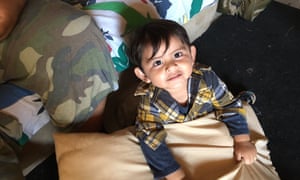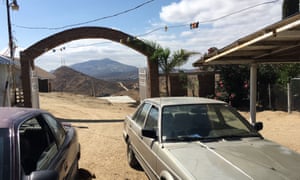The art installation emerged last week near Tecate, highlighting controversy over Trump’s proposed wall – but Kikito’s family would rather stay in Mexico.
The toddler seems to grip the top of the steel fence as he peers into America, his attention focused on something north of the border.
The expression is playful but his scale – 65ft – dwarfs the fence, making it look puny and eminently climbable.
JR, a French visual artist, unveiled the monumental photo last week on the outskirts of Tecate, a Mexican town bordering California.
The installation has become a tourist magnet amid renewed focus on Donald Trump’s proposed border wall to block purported would-be immigrant hordes.
The toddler, it turns out, isn’t among them. Nor is his family. From their yard, they can reach through the fence and touch US soil but don’t really see the point. They prefer life in Mexico.
“I want to stay and work here,” said Lizy Higareda, 24, in Spanish, as her 17-month-old son, Kikito, played at her feet in the family’s living room. “My career, my roots, are here.”
Lizy Higareda and her son Kikito at home in Tecate, Mexico. Photograph: Rory Carroll for the Guardian
The photo of Kikito shows him gazing into the US, but curiosity was not the same as yearning, said his mother, a student and part-time bodega worker. “Our lives are in Tecate. It’s a good life, peaceful.”
Would she ever want to visit the US? She shrugged. “Disneyland and Hawaii, sure.”
Higareda can feel a California breeze in her kitchen but is content to stay in Mexico, as are most Mexicans. Since the great recession, in fact, more Mexican immigrants are leaving the US than entering, according to the Pew Research Center.
This historic reversal did not dent Trump’s promise in last year’s election to build a “big, beautiful wall” to keep out “bad hombres” and other undesirables. A tentative immigration deal with Democrats has clouded the wall’s fate.
Higareda’s father, José, 82, a retired schoolteacher, briefly lived in the US and has permanent residency papers but prefers Tecate, which sits in a valley 40 miles east of San Diego. “I’m very proud to be Mexican. It’s a good life, there’s dignity. You can have liberty and work.”
Jose Higareda, Kikito’s grandfather, at the family home. Photograph: Rory Carroll for the Guardian
Ironically Kikito, whose image looms over the fence a short walk from the family home, has become a symbol of northbound human traffic – those currently trying to cross the border and the so-called Dreamers brought as children.
Trump’s rhetoric about a wall inspired JR, who has been called a French version of Banksy, to conjure the image of a child looking over the border. While scouting locations he encountered the Higaredas, who gave him permission to photograph Kikito and turn the image into a temporary installation.
The artist included a Google Maps pin on his Instagram profile, which has a million followers, to help people find the installation. You can view it from either side of the border. It is due to come down in early October.
“Kikito’s famous now,” said Rosario Armenta, a Mexican visitor. “I see him as a little angel saying something to the United States, something about the Latinos who go there.”
Rosario Armenta takes a photo of the installation. Photograph: Rory Carroll for the Guardian
A real estate developer from San Diego who gave his name only as Kevin admired it from the US side. “It’s pretty classic what they did with the kid. We should allow more Mexicans to enter legally.”
The number of undocumented border crossers is near a historic low. During the 2016 fiscal year the US Border Patrol caught 80 people crossing the border illegally near Tecate.
The Higaredas hope Kikito will never feel forced to leave his home, a rambling brick structure atop a hill adorned with dozens of family portraits and a yard boasting an ancient Pontiac, an even older Nissan, four cats, five dogs and 18 chickens.
The local school is fine and Tecate is “magical”, said his mother, with a wry smile and air quotes. The town, best known for a brewery which bears its name, is on a federal list of Pueblos Mágicos, places notable for natural beauty or historical or cultural significance.
It is quiet and friendly, said Higareda, but also has corruption and occasional violence, blowback from the drug war ravaging other parts of Mexico.
She hopes to finish a criminology degree next year and to work as a jail therapist. “I don’t want to fight the drug war. I want to help end it.”
Meantime she supplements her husband’s meagre factory wages and her father’s pension by working three days a week in a bodega, earning $23 over that period. “When Kikito took his first steps, I was at work,” she rued. “The first time he said mama, I was at work.”
She hopes Kikito will learn English – he would be the first in his family – in order to earn a better wage, not to emigrate.
He is her first – and last – child, said Higareda. The pregnancy was tough and money is tight. “He’s become my world, but no more.” Mexico’s fertility rate, once among the world’s highest, has plunged to nearly that of the US, another reason there are fewer people trekking north.
During the interview, Tecate’s local celebrity played with a shoe, scrambled over a sofa, scrutinised a cat, emptied a bag, squeezed a pillow and wandered in and out of the kitchen – where his grandmother prepared lunch – before falling asleep in his mother’s lap, guzzling a bottle of milk.
Kikito plays on the floor at home. Photograph: Rory Carroll for the Guardian
“He still doesn’t know what’s on the other side of the fence,” said his mother. “He doesn’t know that Donald Trump thinks Mexicans are killers and rapists. He’s just innocent, curious.”
JR explained the installation in advance and gifted her a book titled Can Art Change the World?, but the scale of the work still came a surprise, she said. “So big. And I didn’t realise people would be interested in Kikito.”
Tourists coo over him and a few give a few dollars for diapers and milk, the family’s only financial gain from the project, which is fine by them. “It’s not about money, it’s about a special thing happening so early in his life,” said Higareda.
Jose, the grandfather, beamed in agreement. “The whole world wants to hug him.”
The view overlooking the US border from Kikito’s family home. Photograph: Rory Carroll for
Source: theguardian.com
